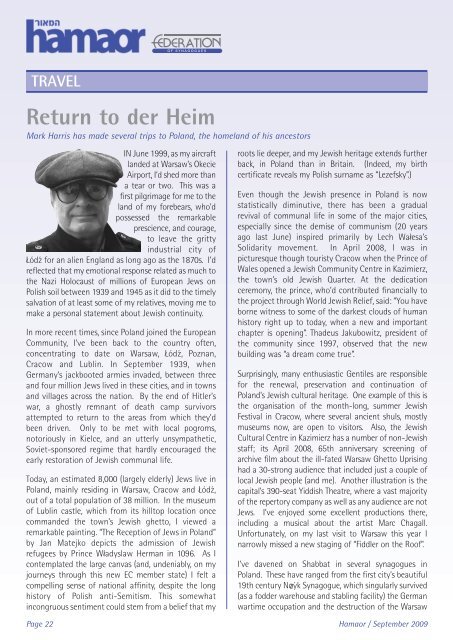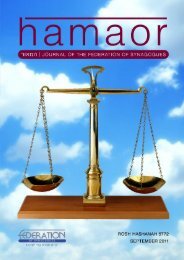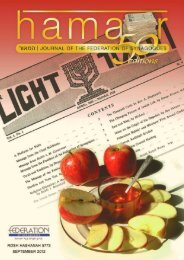20903 Hamoar cover - Federation Of Synagogues
20903 Hamoar cover - Federation Of Synagogues
20903 Hamoar cover - Federation Of Synagogues
You also want an ePaper? Increase the reach of your titles
YUMPU automatically turns print PDFs into web optimized ePapers that Google loves.
TRAVEL<br />
Return to der Heim<br />
Mark Harris has made several trips to Poland, the homeland of his ancestors<br />
IN June 1999, as my aircraft<br />
landed at Warsaw’s Okecie<br />
Airport, I’d shed more than<br />
a tear or two. This was a<br />
first pilgrimage for me to the<br />
land of my forebears, who’d<br />
possessed the remarkable<br />
prescience, and courage,<br />
to leave the gritty<br />
industrial city of<br />
⁄Lódź for an alien England as long ago as the 1870s. I’d<br />
reflected that my emotional response related as much to<br />
the Nazi Holocaust of millions of European Jews on<br />
Polish soil between 1939 and 1945 as it did to the timely<br />
salvation of at least some of my relatives, moving me to<br />
make a personal statement about Jewish continuity.<br />
In more recent times, since Poland joined the European<br />
Community, I’ve been back to the country often,<br />
concentrating to date on Warsaw, ⁄Lódź, Poznan,<br />
Cracow and Lublin. In September 1939, when<br />
Germany’s jackbooted armies invaded, between three<br />
and four million Jews lived in these cities, and in towns<br />
and villages across the nation. By the end of Hitler’s<br />
war, a ghostly remnant of death camp survivors<br />
attempted to return to the areas from which they’d<br />
been driven. Only to be met with local pogroms,<br />
notoriously in Kielce, and an utterly unsympathetic,<br />
Soviet-sponsored regime that hardly encouraged the<br />
early restoration of Jewish communal life.<br />
Today, an estimated 8,000 (largely elderly) Jews live in<br />
Poland, mainly residing in Warsaw, Cracow and ⁄Lódź,<br />
out of a total population of 38 million. In the museum<br />
of Lublin castle, which from its hilltop location once<br />
commanded the town’s Jewish ghetto, I viewed a<br />
remarkable painting. “The Reception of Jews in Poland”<br />
by Jan Matejko depicts the admission of Jewish<br />
refugees by Prince W⁄ladyslaw Herman in 1096. As I<br />
contemplated the large canvas (and, undeniably, on my<br />
journeys through this new EC member state) I felt a<br />
compelling sense of national affinity, despite the long<br />
history of Polish anti-Semitism. This somewhat<br />
incongruous sentiment could stem from a belief that my<br />
roots lie deeper, and my Jewish heritage extends further<br />
back, in Poland than in Britain. (Indeed, my birth<br />
certificate reveals my Polish surname as “Lezefsky”.)<br />
Even though the Jewish presence in Poland is now<br />
statistically diminutive, there has been a gradual<br />
revival of communal life in some of the major cities,<br />
especially since the demise of communism (20 years<br />
ago last June) inspired primarily by Lech Wa⁄lesa’s<br />
Solidarity movement. In April 2008, I was in<br />
picturesque though touristy Cracow when the Prince of<br />
Wales opened a Jewish Community Centre in Kazimierz,<br />
the town’s old Jewish Quarter. At the dedication<br />
ceremony, the prince, who’d contributed financially to<br />
the project through World Jewish Relief, said: “You have<br />
borne witness to some of the darkest clouds of human<br />
history right up to today, when a new and important<br />
chapter is opening”. Thadeus Jakubowitz, president of<br />
the community since 1997, observed that the new<br />
building was “a dream come true”.<br />
Surprisingly, many enthusiastic Gentiles are responsible<br />
for the renewal, preservation and continuation of<br />
Poland’s Jewish cultural heritage. One example of this is<br />
the organisation of the month-long, summer Jewish<br />
Festival in Cracow, where several ancient shuls, mostly<br />
museums now, are open to visitors. Also, the Jewish<br />
Cultural Centre in Kazimierz has a number of non-Jewish<br />
staff; its April 2008, 65th anniversary screening of<br />
archive film about the ill-fated Warsaw Ghetto Uprising<br />
had a 30-strong audience that included just a couple of<br />
local Jewish people (and me). Another illustration is the<br />
capital’s 390-seat Yiddish Theatre, where a vast majority<br />
of the repertory company as well as any audience are not<br />
Jews. I’ve enjoyed some excellent productions there,<br />
including a musical about the artist Marc Chagall.<br />
Unfortunately, on my last visit to Warsaw this year I<br />
narrowly missed a new staging of “Fiddler on the Roof”.<br />
I’ve davened on Shabbat in several synagogues in<br />
Poland. These have ranged from the first city’s beautiful<br />
19th century No´ zyk Synagogue, which singularly survived<br />
(as a fodder warehouse and stabling facility) the German<br />
wartime occupation and the destruction of the Warsaw<br />
Page 22<br />
Hamaor / September 2009










